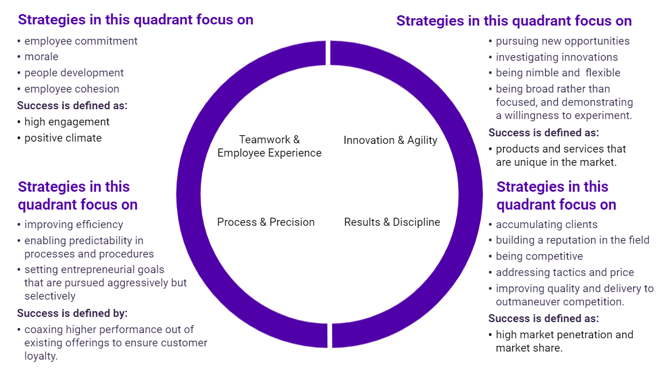The Design Phase of Talent Optimization
Learn how top business leaders use Design to build high-performing teams that are aligned with, and ready to, execute on your business strategy.
Have you ever wondered where your team has “gaps”?
Gaps between the talent on a team and the needs of the business can be like having a professional football team with an inferior offensive line. The quarterback may be the greatest of all time, but they will struggle to score and win games if the O-line can’t protect their QB.
In the Design phase of Talent Optimization, we work with business leaders to map their strategy to their organizational structure and current team members.
The Design phase helps leaders understand their teams’ strengths and potential blind spots and how these teams align with the organization’s strategy.
Companies That Align Talent with Business Strategy:
-
Outperform Others by 16%
-
Retain 30% More Top-Performers
-
See 34% Higher Employee Performance
*According to The State of Talent Optimization Report. In This Study by The Predictive Index, 600 Executives—including 200 CEOs—Reveal the Talent Optimization Practices that Drive Superior Business Results.
New to the concept of Talent Optimization? Take a moment to check out our What is Talent Optimization post for some background on the discipline of Talent Optimization.
The Talent Optimization Process

If you’ve read the book Good to Great by Jim Collins, you’re probably familiar with his bus analogy:
“If we get the right people on the bus, the right people in the right seats, and the wrong people off the bus, then we’ll figure out how to take it someplace great.”
Most business leaders have referred to this concept at least once in their careers.
But when you ask them how they do this, their response is somewhat vague.
Their answer generally falls into the category of “gut feel”.
While gut feel and intuition have their place, it is hard to replicate and scale across an organization.
Replacing Gut Feel With Team-Level People Data
Utilizing the Design aptitude of Talent Optimization, powered by The Predictive Index (PI) software, we help business leaders move from “gut feel” to data-driven.
Taking a data-driven approach to people and how that links to the organization’s strategy is crucial during periods of transformation, especially when implementing growth strategies or a transition plan.
The Design phase is essential because it clearly shows two things:
- The natural behaviors of those primarily responsible for executing the strategy.
- The skills needed to execute the business’s strategy most efficiently.
In the Design phase, leaders can identify gaps and friction points in the people portion of their strategy. A data-driven approach allows leaders to improve efficiency by decreasing team assessment time while also removing the subjectivity and bias that results from relying only on the narrow lens of one’s personal experiences.
In the Design phase, leaders will learn this important concept:
“Who’s in the room, who’s in the building, and who’s on the street.”
The “room, building, street” concept is crucial for leaders at every level to learn and understand.
Here is a high-level overview of the concept:
Who’s in the Room?
“The Room” represents the core members of the team. These team members are responsible for executing strategic objectives such as:
- Increasing employee loyalty
- Increasing market share
- Reducing waste
- Implementing new processes and procedures
Who’s in the Building?
“The Building” represents employees in the organization who have the requisite skills for executing a particular strategy but are not necessarily members of the core team. These individuals can be great resources for the core team to utilize and include in executing the team’s strategy.
Who’s on the Street?
Sometimes, the company needs skills that are not in the room or building.
This is not unusual, especially when companies are going through periods of rapid growth or change.
In these instances, company’s often must look outside the organization to recruit the talent and skills needed to execute their strategy.
When applying the “who’s in the room, who’s in the building, and who’s on the street” concept, keep in mind that just because a team member falls outside a quadrant most closely associated with your strategy, that doesn’t mean they can’t execute the strategy. However, it does mean it may take more effort than it would for those who naturally have those behavioral traits.
Effort & Execution
After analyzing millions of behavioral assessments, Predictive Index has identified 17 reference profiles that create behavioral maps for different types of people. These reference profiles are then placed in PI’s Behavioral Quadrants so that individuals, as well as leaders, can visualize how team members work relative to others in the organization.

Predictive Index Behavioral Quadrants
- Innovation & Agility – Visionary, innovative, and risk-oriented. These individuals are quick to make connections and comfortable in uncertain situations.
- Results & Discipline – Driven, competitive, and demanding. These individuals are focused on goals and disciplined with rules.
- Process & Precision – Well-organized, coordinated, and efficient. These individuals build connections selectively and work to minimize risk.
- Teamwork & Employee Experience – Supportive, transparent, and empathetic. These individuals are people-oriented and lenient with rules.
Everyone falls into one of these categories. While a team member may exhibit traits found in other categories, the traits in their specific category come the most natural.
To illustrate the effort level relative to natural behavioral quadrants, let’s compare it to walking, jogging, and running.
When individuals work within the behavioral quadrant most natural to them, the effort level required is relatively low. The exertion is similar to walking. There is minimal effort required, and you can probably sustain this effort for extended periods of time.
When individuals are executing strategies that require traits adjacent to their natural behavioral quadrant, the effort level increases. This would be similar to jogging. It takes more effort than walking, and can only be sustained for short durations of time.
When individuals are executing strategies that are opposite to their natural behavioral quadrant, the required effort level is high. This can best be described as running. It takes a great deal of effort, and can only be sustained for brief periods before needing to rest.
As with most things, individuals, as well as teams, can work to build skills in areas that come less natural to them. Over time, through repeated efforts and awareness, individuals can increase their skills – or stamina when thinking about our walk, jog, run illustration – thereby reducing the effort needed to work outside their natural behavioral quadrant.
The Four Steps of the Design Phase
Now that you understand the makeup of your core team members, their natural styles, and the effort level required by each team member, it is time to jump into the four primary activities of the Design phase.
Step One: Select the organization’s structure
Your company’s business strategy provides the context for effective organizational structure. A company’s organizational structure should allow for easy execution of the strategy and should be updated as needed to reduce friction points and inefficiencies.
Step Two: Evaluate the leadership team’s fit
The execution of a given business strategy will require certain skills. Map your core team’s competencies to the strategy, identify the current teams fit, and identify any gaps or blind spots.
Step Three: Understand team dynamics
The team needs to work well together to execute the businesses strategy. It is essential that each team member develops self-awareness as well as awareness of the group’s similarities and differences.
Step Four: Identify cultural gaps
Your company culture and business strategy must be aligned. To ensure alignment, it’s necessary to map cultural factors to the strategy, identifying and addressing any area of misalignment.
While these four steps might seem like common sense, it is one of the most overlooked activities in strategy development.
If you would like to learn more about how we are helping organizations utilize talent optimization to create a competitive advantage for their business, give us a call, or drop us an email, we would welcome the opportunity to learn more about your business and the challenges you are facing.
About Jeff
Jeff has over 30 years of strategic planning, business development, and business transformation leadership experience. Having worked with mid-market, closely-held and family-owned businesses his entire career Jeff has a unique understanding of how these enterprises operate and the challenges they face.
He is passionate about working with business leaders to build strong cultures while developing and executing strategies that deliver exceptional results that benefit all the company’s stakeholders. Jeff’s hands-on approach to working with companies begins with a commonsense approach to strategy development.
With extensive experience in organizational turnaround and growth Jeff follows a defined process (disciplined, focused, intentional) to guide clients from strategy to execution. His experience covers a multitude of industries, with an in-depth understanding of automotive manufacturing.
Jeff holds a Master’s in Business Administration from the Capital University School of Management and earned a Bachelor of Arts in Business Administration and Management from Ohio Dominican University.



